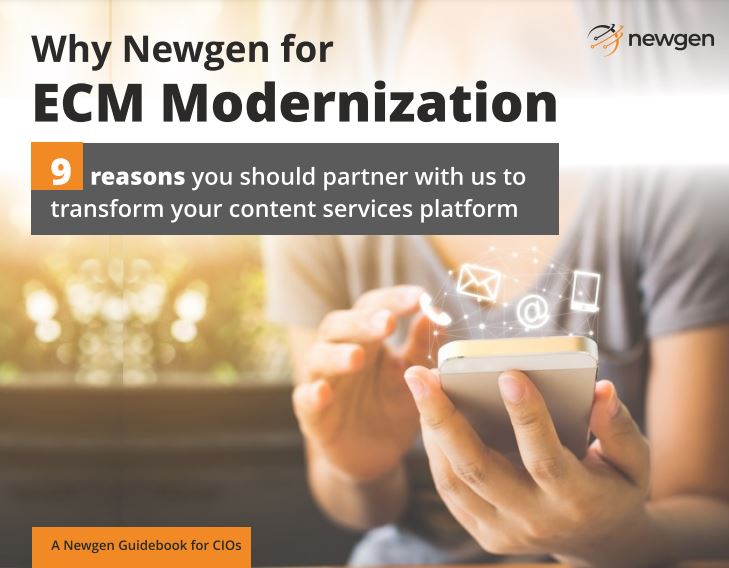Why ECM Modernization Matters Now?
In an era defined by digital transformation, data explosion, and remote collaboration, enterprises are realizing that their legacy Enterprise Content Management (ECM) systems can no longer meet evolving business needs.
Traditional ECMs — once the foundation of enterprise document management — are now bottlenecks to agility, unable to support cloud-native operations, AI-driven insights, or cross-enterprise collaboration. According to IDC, by 2026, 75% of large organizations will replace or significantly modernize their legacy ECMs to stay competitive.
This eBook explores the strategic and operational imperatives driving ECM modernization and how a modern, AI-powered content services platform like NewgenONE OmniDocs empowers enterprises to transition from document management to content intelligence.
The Pitfalls of Legacy ECM Systems
Outdated ECM systems were built for an earlier era — centralized, on-premises, and repository-centric. They now pose significant challenges in the digital economy:
- Limited Scalability: Struggle to handle growing volumes of content and data sources.
- Fragmented Architecture: Disconnected systems make information retrieval slow and inconsistent.
- High Maintenance Costs: Frequent patches, complex integrations, and security updates drain resources.
- Poor User Experience: Clunky interfaces and restricted access frustrate users.
- Compliance Gaps: Legacy systems lack modern audit, retention, and governance features.
These limitations hinder productivity, reduce compliance confidence, and block innovation — especially as organizations adopt cloud, AI, and hybrid work models.
The Business Case for Modernization
Modernizing ECM is not just an IT upgrade — it’s a business transformation initiative.
- Enhancing Business Agility
A modern ECM integrates seamlessly with enterprise ecosystems (CRM, ERP, BPM) through APIs and microservices, enabling dynamic, end-to-end workflows.
- Driving Operational Efficiency
Automation eliminates manual intervention in document ingestion, classification, and processing. AI/ML models can detect document types, extract data, and trigger workflows instantly.
- Improving Collaboration and Accessibility
Cloud-based ECM solutions allow secure access to documents anytime, anywhere, empowering remote and hybrid teams.
- Ensuring Compliance and Security
Modern ECMs feature automated retention policies, encryption, and access control, ensuring alignment with regulations like GDPR, HIPAA, and ISO 27001.
- Lowering Total Cost of Ownership (TCO)
By consolidating content into a unified platform, enterprises reduce licensing, infrastructure, and maintenance costs — achieving faster ROI.
Modernization Pathways: Evolution, Migration, and Transformation
There’s no one-size-fits-all approach to ECM modernization. Enterprises typically follow one of three pathways based on current maturity and future goals:
- Evolution
Incremental upgrades to existing ECMs to improve performance, UI, or integration capabilities — ideal for short-term efficiency gains.
- Migration
Replatforming content and workflows from legacy systems to a modern, cloud-ready ECM while retaining critical metadata, access controls, and audit history.
- Transformation
A complete reinvention of the content ecosystem — integrating AI, analytics, and low-code capabilities to build content-driven digital experiences.
Each pathway requires meticulous planning to ensure data integrity, user adoption, and minimal disruption.
5 Key Considerations for a Successful ECM Modernization
- Content Assessment — Evaluate legacy repositories, classify content types, and identify redundant or outdated data.
- Cloud Readiness — Choose the right deployment model (public, private, hybrid) based on compliance and scalability needs.
- Integration Framework — Ensure API and microservices compatibility for smooth data flow across business systems.
- Governance and Compliance — Automate policies to manage retention, access, and audit logs.
- User-Centric Design — Prioritize intuitive UI/UX to enhance user adoption and collaboration.
A modern ECM must not just manage content — it must make it contextual, intelligent, and actionable.
How NewgenONE OmniDocs Powers ECM Modernization?
NewgenONE OmniDocs Contextual Content Services Platform enables enterprises to reimagine content management for agility, compliance, and intelligence.
Core Capabilities
- Unified Content Repository: Consolidate fragmented data into a centralized, scalable system.
- AI-Driven Automation: Classify documents, extract metadata, and trigger workflows automatically.
- Low-Code Development: Rapidly build custom applications and integrations without heavy coding.
- Cloud-Native Architecture: Deploy on-premises, cloud, or hybrid environments for maximum flexibility.
- Advanced Security: Role-based access, encryption, and secure audit trails for governance assurance.
- Federated Search and Insights: Access, retrieve, and analyze documents across repositories in seconds.
NewgenONE OmniDocs goes beyond traditional ECM by enabling content-centric business applications that drive operational excellence and customer experience.
Migration with Confidence: Seamless Transition from Legacy Systems
Newgen’s ECM modernization framework ensures a smooth, low-risk migration from legacy platforms such as FileNet, OpenText, Documentum, Oracle WebCenter, and SharePoint.
Key Features of Newgen’s Migration Approach
- Automated Tools for data extraction, mapping, and validation.
- Metadata Retention to maintain document lineage and compliance.
- Parallel System Operations to ensure zero downtime during migration.
- AI-Based Quality Checks to verify data integrity post-migration.
By combining automation and expertise, Newgen helps enterprises migrate billions of documents with minimal disruption.
Measurable Business Outcomes
Organizations that modernize with NewgenONE achieve:
- 60% faster content retrieval times.
- Up to 40% reduction in operational costs.
- Improved compliance and audit readiness.
- Accelerated go-to-market for digital initiatives.
These outcomes translate into enhanced productivity, lower risk, and a more agile, connected enterprise.
The Future of ECM: From Content Management to Content Intelligence
The next evolution of ECM lies in AI-driven content intelligence, where systems not only manage content but also understand it.
By combining AI, NLP, and predictive analytics, modern ECMs can:
- Summarize large volumes of data automatically.
- Identify compliance risks proactively.
- Recommend next-best actions for employees.
- Personalize content delivery across customer touchpoints.
With such capabilities, ECM modernization becomes a strategic enabler of enterprise agility, resilience, and innovation.
Begin Your ECM Modernization Journey
Transform your legacy ECM into an intelligent, cloud-native content services platform that drives business outcomes.

